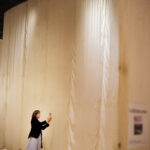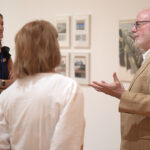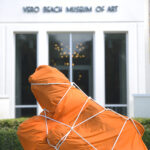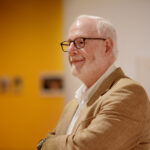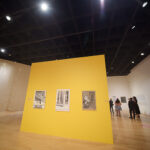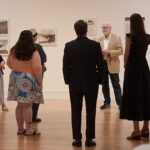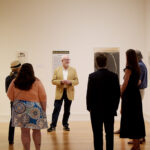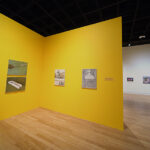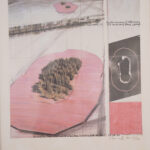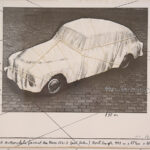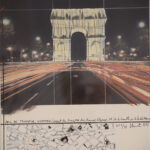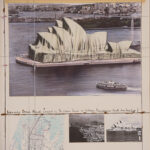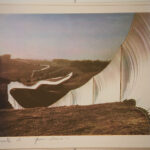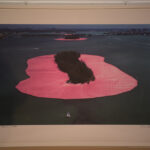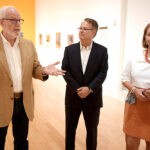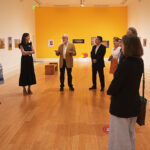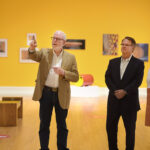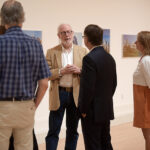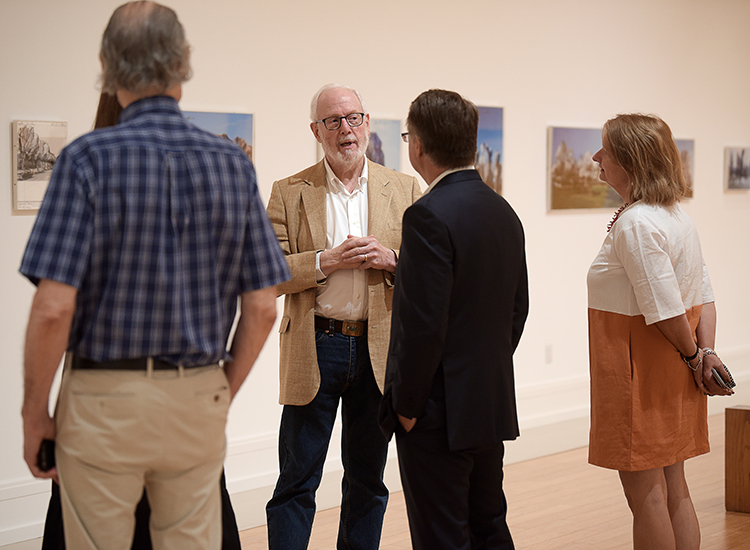
It’s been 19 years since the Vero Beach Museum of Art presented a Christo and Jeanne-Claude exhibition. Like the VBMA’s current offering, on view through Sept. 5, that long-ago show of collage drawings, prints and multiples, and small wrapped objects was drawn from the collection of Californian Tom Golden (1921-2002).
The collection, which Golden donated to the Sonoma County Museum in 2001, was shown in the Holmes Gallery right around the time Golden died, in late 2002, closing on Jan. 3, 2003.
The biggest difference between the Golden Collection show then and now is that Christo and Jeanne-Claude visited the VBMA during the previous exhibition. That cannot happen again.
Famously born on the same day, June 13, 1935 (Christo in Bulgaria and Jeanne-Claude in Morocco), the pair’s joined creative life began when they met in Paris, in 1958. They married the following year and were parted half a century later by Jeanne-Claude’s death in November 2009. Christo died last May.
The current VBMA exhibition, on display in the Holmes and Titelman Galleries, documents through artworks Golden’s 28-year acquaintance with the artists. Organized by the Sonoma County Museum, the show has appeared in small museums throughout the U.S. for the past decade via Landau Traveling Exhibitions.
A retired real estate broker, Golden met Christo and Jeanne-Claude in 1974 at a public hearing for the “Running Fence” project. In a 2000 interview for the online journal Art A GoGo, Golden said that he was in the planning department at the Sonoma County government office in Santa Rosa when “I saw a lot of people with cameras. I was told that it had to do with the next scheduled hearing for the artist Christo.”
Intrigued, Golden went to the hearing, where numerous lengthy objections to the project were voiced by local citizens, environmentalists and others.
“Finally, I got up and said, ‘I resent this meeting today wasting the taxpayers’ money. Here’s a man who wants to come to Sonoma County, on private property, and put up a fence. If I read the ordinance right, no permit is required on private property if it’s ‘cross fencing.’ I’d just like to remind this commission that a fence is a fence, it doesn’t make any difference if it’s wood, barbed wire, wire or nylon 18-foot tall.’ And I sat down. Right after that, Christo and Jeanne-Claude came over to me and said, ‘Thank you very much for your testimony.’ And I replied, ‘Oh, I think you’ll get your fence. It will be tough, but I’ll help you in any way I can.’”
That was the serendipitous beginning of Golden’s role as close friend, project manager and, Golden claimed, father-figure to the famous duo. Golden liked to say that he amassed his collection by trading his physical labor and business know-how as a project manager with Christo and Jeanne-Claude for artworks rather than cash.
“He also was paid,” says Jonathan Henery, office manager for Christo and Jeanne-Claude’s business entity, CVJ Corporation.
Henery was Jeanne-Claude’s full-time assistant from 1996 to her death in 2009. He continues to manage the office to this day and has worked as a writer and editor on several books about the couple and their projects.
Concerning Golden’s status as a paid worker for Christo and Jeanne-Claude, it important to know that the artists did not allow people to volunteer for projects. Everybody who worked as a project team member received remuneration; union wages for specialized professional workers and just above minimum wage for non-skilled workers.
Henery says there were several reasons for this, but “most importantly, one cannot easily fire volunteers when necessary.”
He adds that if a team member were injured on the job, they would be entitled to worker’s compensation. This practical solution to a thorny problem is an example of how Christo and Jeanne- Claude were able to achieve great things in concert with many people.
After Jeanne-Claude died, Christo continued to work on the couple’s projects until his own death. One of those projects will be realized post-mortem. “L’Arc de Triomphe, Wrapped,” a temporary artwork for Paris, will be on view for 16 days from Saturday, Sept. 18 to Sunday, Oct. 3.
The realization of that project was sanctioned by Christo before his death. Both he and Jeanne-Claude intended for their active projects to be continued to their concrete completion, even if they were not around to see them.
A 2009 Washington Post obituary for Jeanne-Claude quoted her as saying, “Artists don’t retire. They die. That’s all. When they stop being able to create art, they die.”
For Christo and Jeanne-Claude, the end will come when their final work in progress is realized. Conceived in 1977, “The Mastaba, A Project for Abu Dhabi” is a bunker-like configuration of 410,000 multi-colored 55-gallon barrels. The form, if not the material used for the project, echoes that of the flat-roofed tombs of ancient Egypt. The Mastaba will be the artists’ only permanent large-scale work.
Whether or not that project comes to pass, the boldness of its scale and its seemingly impossible execution is pure Christo and Jeanne-Claude.
The magnificent scale of the “Running Fence” project that brought Christo, Jeanne-Claude and Tom Golden together is well-illustrated in the current exhibition by a 60-foot-long by 18-foot-high white nylon fabric section of the fence. On loan from the School of Art Collection and Galleries of Kent State University, the enormous white curtain snakes through the middle of the Holmes Gallery. This section was but one of 2,050 that made up the 24 ¼-mile long fence.
On display from the Golden Collection, an original drawing collage for the “Running Fence” project and photos by Wolfgang Volz of the realized project do not bring the immensity of the artwork home to viewers as completely as does this stained rectangle of fabric.
Other artworks on view include “Wrapped Reichstag,” Berlin; “The Umbrellas,” Japan and USA; “The Pont Neuf Wrapped,” Paris; “Surrounded Islands,” Biscayne Bay, Greater Miami; and “Valley Curtain,” Rifle, Colo.
Plenty of projects conceived of by Christo and Jeanne-Claude were not realized. They always had many irons in the fire; if one project did not work out, they abandoned it in favor of those that were moving forward.
Perhaps the largest of those unrealized works, “Over The River” would have suspended almost 6 miles of fabric panels high above the waters of the Arkansas River in south-central Colorado.
In 2017, the 81-year-old Christo issued this online statement: “After pursuing ‘Over The River, Project for the Arkansas River, State of Colorado,’ for 20 years and going through five years of legal arguments, I no longer wish to wait on the outcome.”
That project is represented in the current show by a trio of Christo’s original collages, composed of photographs with pencil, crayon, enamel paint, charcoal and tape. Two of these are 1993 works from the Tom Golden Collection, and a 1999 work is on loan from the collection of long-time VBMA supporter Georgia Welles.
As awe-inspiring as the large projects are for Christo’s fans to contemplate, it is the human-sized wrapped objects that Christo created throughout his career that will stick with the visitor.
These include prints and small-edition multiples that picture everything from a Radio Flyer wagon and a bulky lounge chair, to a slender nude woman.
Photos by Brenda Ahearn

